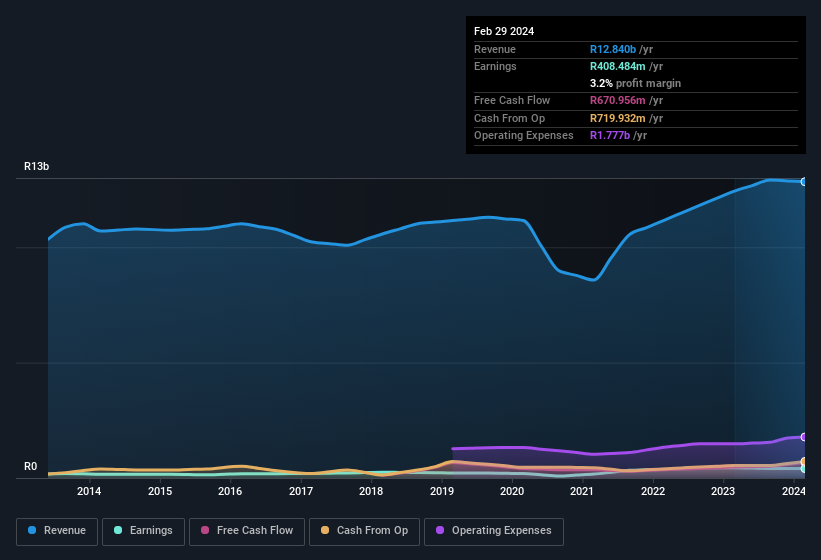- South Africa
- /
- Specialty Stores
- /
- JSE:CMH
There May Be Some Bright Spots In Combined Motor Holdings' (JSE:CMH) Earnings
Soft earnings didn't appear to concern Combined Motor Holdings Limited's (JSE:CMH) shareholders over the last week. We think that the softer headline numbers might be getting counterbalanced by some positive underlying factors.
See our latest analysis for Combined Motor Holdings

Examining Cashflow Against Combined Motor Holdings' Earnings
Many investors haven't heard of the accrual ratio from cashflow, but it is actually a useful measure of how well a company's profit is backed up by free cash flow (FCF) during a given period. In plain english, this ratio subtracts FCF from net profit, and divides that number by the company's average operating assets over that period. You could think of the accrual ratio from cashflow as the 'non-FCF profit ratio'.
Therefore, it's actually considered a good thing when a company has a negative accrual ratio, but a bad thing if its accrual ratio is positive. That is not intended to imply we should worry about a positive accrual ratio, but it's worth noting where the accrual ratio is rather high. Notably, there is some academic evidence that suggests that a high accrual ratio is a bad sign for near-term profits, generally speaking.
Over the twelve months to February 2024, Combined Motor Holdings recorded an accrual ratio of -0.15. That indicates that its free cash flow quite significantly exceeded its statutory profit. To wit, it produced free cash flow of R671m during the period, dwarfing its reported profit of R408.5m. Combined Motor Holdings shareholders are no doubt pleased that free cash flow improved over the last twelve months.
Note: we always recommend investors check balance sheet strength. Click here to be taken to our balance sheet analysis of Combined Motor Holdings.
Our Take On Combined Motor Holdings' Profit Performance
Combined Motor Holdings' accrual ratio is solid, and indicates strong free cash flow, as we discussed, above. Based on this observation, we consider it likely that Combined Motor Holdings' statutory profit actually understates its earnings potential! Better yet, its EPS are growing strongly, which is nice to see. The goal of this article has been to assess how well we can rely on the statutory earnings to reflect the company's potential, but there is plenty more to consider. Keep in mind, when it comes to analysing a stock it's worth noting the risks involved. For example, we've discovered 1 warning sign that you should run your eye over to get a better picture of Combined Motor Holdings.
Today we've zoomed in on a single data point to better understand the nature of Combined Motor Holdings' profit. But there are plenty of other ways to inform your opinion of a company. For example, many people consider a high return on equity as an indication of favorable business economics, while others like to 'follow the money' and search out stocks that insiders are buying. So you may wish to see this free collection of companies boasting high return on equity, or this list of stocks with high insider ownership.
New: AI Stock Screener & Alerts
Our new AI Stock Screener scans the market every day to uncover opportunities.
• Dividend Powerhouses (3%+ Yield)
• Undervalued Small Caps with Insider Buying
• High growth Tech and AI Companies
Or build your own from over 50 metrics.
Have feedback on this article? Concerned about the content? Get in touch with us directly. Alternatively, email editorial-team (at) simplywallst.com.
This article by Simply Wall St is general in nature. We provide commentary based on historical data and analyst forecasts only using an unbiased methodology and our articles are not intended to be financial advice. It does not constitute a recommendation to buy or sell any stock, and does not take account of your objectives, or your financial situation. We aim to bring you long-term focused analysis driven by fundamental data. Note that our analysis may not factor in the latest price-sensitive company announcements or qualitative material. Simply Wall St has no position in any stocks mentioned.
About JSE:CMH
Combined Motor Holdings
An investment holding company, engages in the motor retail and distribution business in South Africa.
Good value with adequate balance sheet.
Similar Companies
Market Insights
Community Narratives



